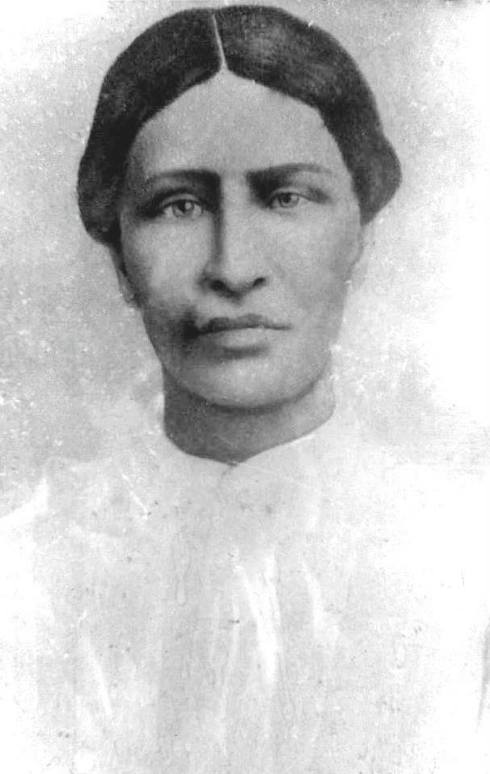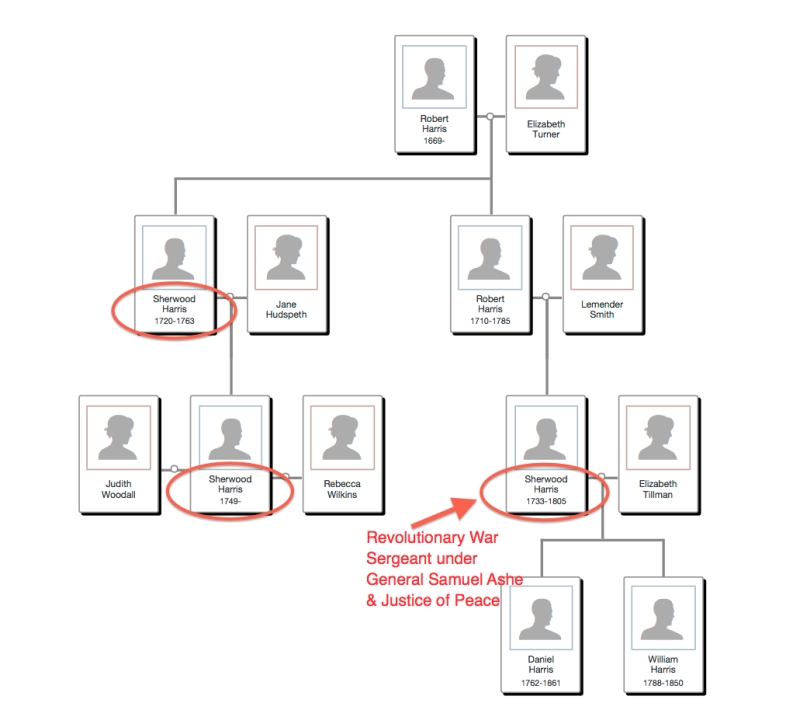I think one of the most common mistakes in doing genealogical work is mixing up the records for people who have the same name. In Granville County in the 1700s, there were at least four men with the name “Sherwood Harris”. One of those men was my 5th great-grandfather Sherwood Harris. The three other men are related to one another but are unrelated to my Sherwood Harris. My Sherwood was Native American, most often listed as a “free person of color” in the records. The other three Sherwood’s were listed as “white”. One would think that this racial distinction along with many diverging life details would help resolve any confusion, but that has not been the case. In this blog post, I’m going to discuss the Revolutionary War pension application of my Sherwood Harris that has quite frequently been attributed to the other Sherwood Harrises. Hopefully this will be a helpful warning to other researchers to take more care in how they attribute records.
My 5th great-grandfather Sherwood Harris (1761-1833) was the son of Edward Harris and Sarah Chavis. Edward Harris was among the founding members of the Native community in Granville. Sarah Chavis’ parents were William Chavis and Frances Gibson, who owned the original land base for the community. Two of Sherwood brother’s named Jesse Harris (1762-1844) and Edward Harris Jr (1756-1792) also fought in the Revolutionary War. Edward Jr died before filing a pension and left no heirs, and Jesse and later his widow Julia (Taborn) Harris successfully filed and received a pension (W.1277).
It is actually incorrect for me to say that Sherwood Harris filed a pension. From after his service in the war and until his death in 1833, Sherwood never filed for a pension. According to witness testimony provided by Nathaniel Estes, Sherwood “felt rather above begging” the government for compensation. However after his passing, his widow Martha/Patsy Harris (maiden name not known) was in financial trouble and had no means of support. So in 1843, she filed a widow’s pension, application number W.3984.
In order to receive a widow’s pension, Martha Harris had several things to prove. For one, she had to prove that she was legally married to Sherwood Harris and had not remarried after his death. She also needed to give proof of his Revolutionary War service including details such as names of captains and battles that would substantiate his record as a soldier. Despite both Martha and her deceased husband Sherwood being illiterate and not being able to leave behind a paper trail, Martha was able to prove her claim to a widow’s pension based off of witness testimony.
The following individuals provided testimony in support of Martha’s application: Frances “Fanny” Cavender, Samuel Chapell, Nathaniel Estes, Peter Cash, Stephen Bridges, and George Pettiford. I have a full un-transcribed copy of the pension application but you can access transcribed portions of the pension application here. George Pettiford (1760-1853) was from the Native American Pettiford family of Granville, and he was the son of founding community member Lawrence Pettiford. George was also a pensioned Revolutionary War veteran and provided testimony that he was well acquainted with Sherwood Harris before the war. He knew that Sherwood had been enlisted, but did not see Sherwood until after the war when they both came back to Granville.
The five remaining testimonies came from white residents of Granville who also knew Sherwood Harris. Samuel Chapell (1757-1845), was a pensioned Revolutionary War veteran who knew Sherwood Harris around the time of the war and believed that Sherwood was a private in Col. William Moore’s regiment for at least two years. Peter Cash (1756-1846) was also a pensioned Revolutionary War veteran and recalled that he served with Sherwood Harris in Col. William Moore’s regiment. He further stated that Sherwood served under a different captain named Capt. Harrison.
Siblings Stephen Bridges (born 1770) and Frances “Fanny” (Bridges) Cavender (born 1765) were personal friends of Sherwood and Martha Harris and knew that their father and older brother served with Sherwood in the Revolutionary War. They both remembered attending Sherwood and Martha’s wedding and provided 1787 as the approximate year of the marriage. And finally Nathaniel Estes (1770-1845) was aclose friend of Sherwood and Martha’s and provided some interesting information about the couple. He said he frequented their home regularly and heard Sherwood speak of being a soldier in the war. He also recalled Sherwood and Martha’s wedding but could not remember the date. However he added that Sherwood had a son who was older than his own son born in 1793 and that this son of Sherwood’s was buried on his property.
The testimony provided by fellow soldiers as well as personal friends, allowed for Martha Harris to receive an annual widow’s pension payment of $80. However Martha Harris was not receiving any money because her pension payments were being illegally withheld by local land agent J.H. Kirkham according to additional testimony from Martha Harris in 1851 and backed up by a letter sent from her attorney William Hunt. As a result Martha was in a state of destitution.

Source: NARA M804. Revolutionary War Pension and Bounty-Land Warrant Application W.3984
Even back in 1844, after initially filing the pension claim, the pension office mixed up Martha’s husband Sherwood Harris with another Sherwood Harris. The other Sherwood Harris had received a bounty land grant for 228 acres and Justice of the Peace Clement Wilkins writing on Martha’s behalf had to explain that it was a different Sherwood Harris who received this land.

Source: NARA M804. Revolutionary War Pension and Bounty-Land Warrant Application. W.3984
As you can see, these Sherwood Harrises have been getting mixed up for quite some time. Finally in 1855, Martha Harris applied for a bounty land grant however there is no further documentation to find out what happened with that application. According to her 1855 testimony, Martha Harris was receiving $80 annually so it appears J.H. Kirkham eventually released her payments or she was issued a new payment certificate. Martha passed away in 1859.

Source: 1850; Census Place: Beaver Dam, Granville, North Carolina; Roll: M432_631; Page: 127A; Image: 252

Source: Marvin Richardson. Please do not reproduce.
So who are these other Sherwood Harrises?
Two of the Sherwoods have a father/son relationship, and the third Sherwood shares an uncle/nephew and 1st cousin relationship with the previous two. Below I created family tree to better illustrate the family relationships:

Most of the genealogical information on the Sherwood Harris family tree above comes from this website. I found many trees on Ancestry that included these Sherwood Harrises, though far too many looked incorrect, had contradictory information and lacked sources. Many of these family trees also had the pension application for my Sherwood Harris attached to these three other Sherwood Harrises. What a mess! But by reviewing some additional records I was able to sort out the records for each of these Sherwoods and determine which of these other Sherwoods was also a Revolutionary War veteran.
Off the bat, I could eliminate the Sherwood Harris (1720-1763) who left a 1763 will because he pre-deceased the Revolutionary War. Several descendants of the other Sherwood Harris (1733-1805) who was also a veteran, filed applications to join Sons of the American Revolution. According to those applications, their ancestor Sherwood Harris was married to an Elizabeth Tillman/Tallman and they claimed descent through two of their sons – Daniel and William Harris. Additionally, they state that their Sherwood Harris fought under General Ashe and was also a Justice of the Peace. They also have 1805 as Sherwood’s death date.

Source: Sons of the American Revolution Membership Applications, 1889-1970. Louisville, Kentucky: National Society of the Sons of the American Revolution. Microfilm, 508 rolls.

Source: Sons of the American Revolution Membership Applications, 1889-1970. Louisville, Kentucky: National Society of the Sons of the American Revolution. Microfilm, 508 rolls.
The 1805 death date of the veteran Sherwood Harris is consistent with the Granville County census records which show 2 white Sherwood Harris head of households for the 1800 census, and only 1 white Sherwood Harris head of household for the 1810 census. So for any researchers of this family, the white Sherwood Harris in the 1810 census is the Sherwood Harris (born 1749) who was NOT the Revolutionary War veteran, and instead was the son of Sherwood Harris Sr. and Jane Hudspeth.
Revisiting the pension application of my Sherwood Harris (1761-1833), it is clear the Pension Office incorrectly filed correspondence letters from the descendants of the other Sherwood Harris (1733-1805) veteran into his folder. The letters from these descendants provide details that are consistent with the other Sherwood Harris. Yet, the Pension Office wrote back to these descendants and provided them with the service information of my Sherwood Harris.

Source: NARA M804. Revolutionary War Pension and Bounty-Land Warrant Application Files. W.3984

Source: NARA M804. Revolutionary War Pension and Bounty-Land Warrant Application Files. W.3984
I hope this blog post will not only clear up any confusion about the many Sherwood Harrises of Granville County, but also serve as a reminder for all of us researchers to be patient and take the time to efficiently sort out and attribute records.

3 thoughts on “The Tale of two (maybe three, four?!) Sherwood Harrises in Granville County”